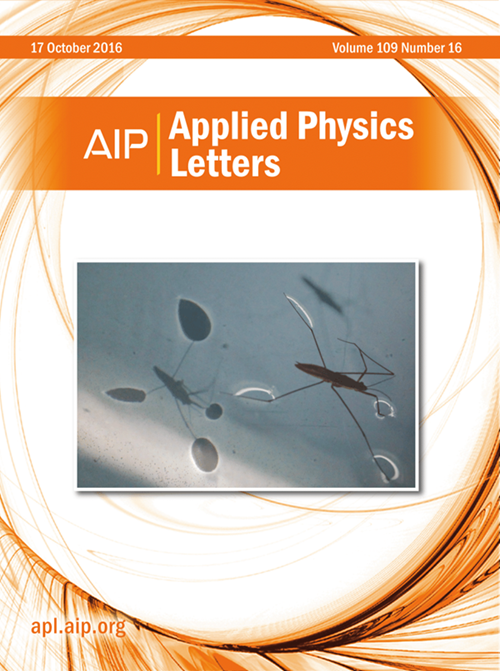Thickness dependence of the electro-optic properties in epitaxial Hf0.5Zr0.5O2 thin films: Evident response down to 3 nm
IF 3.5
2区 物理与天体物理
Q2 PHYSICS, APPLIED
引用次数: 0
Abstract
We investigated the dependence of the electro-optic (EO) properties of (111)-epitaxial Hf0.5Zr0.5O2 (HZO) thin films on their thickness in the range of 3–30 nm. HZO films were deposited on (La, Sr)MnO3-bufferred SrTiO3(001) substrates using pulsed laser deposition. Both the ferroelectric orthorhombic and paraelectric monoclinic phases were found to coexist in the 30 nm thick film, and the fraction of the former phase increased with the decrease in thickness down to 5 nm. Although the effective EO coefficient, reff, remained almost unchanged down to 10 nm and decreased with a further decrease in thickness, the evident EO response was observed down to 3 nm, which agrees with the fact that HZO films can maintain ferroelectric properties down to a few monolayers in thickness. The small reff in the HZO films with thickness below 5 nm was attributed to the stabilization of the ferroelectric rhombohedral-like phase.外延Hf0.5Zr0.5O2薄膜电光特性的厚度依赖性:低至3nm的明显响应
我们研究了(111)-外延Hf0.5Zr0.5O2 (HZO)薄膜的电光(EO)性能在3 ~ 30 nm范围内与薄膜厚度的关系。采用脉冲激光沉积技术在(La, Sr) mno3缓冲的SrTiO3(001)衬底上沉积了HZO薄膜。在30 nm厚的薄膜中,铁电正交相和副电单斜相同时存在,且在5 nm厚的薄膜中,铁电正交相的比例随着厚度的减小而增加。虽然有效的EO系数reff在10 nm以下几乎没有变化,并且随着厚度的进一步减小而减小,但在3 nm以下观察到明显的EO响应,这与HZO薄膜在几层厚度的情况下可以保持铁电性能的事实一致。在厚度小于5 nm的HZO薄膜中,由于铁电菱形相的稳定,薄膜的折射率很小。
本文章由计算机程序翻译,如有差异,请以英文原文为准。
求助全文
约1分钟内获得全文
求助全文
来源期刊

Applied Physics Letters
物理-物理:应用
CiteScore
6.40
自引率
10.00%
发文量
1821
审稿时长
1.6 months
期刊介绍:
Applied Physics Letters (APL) features concise, up-to-date reports on significant new findings in applied physics. Emphasizing rapid dissemination of key data and new physical insights, APL offers prompt publication of new experimental and theoretical papers reporting applications of physics phenomena to all branches of science, engineering, and modern technology.
In addition to regular articles, the journal also publishes invited Fast Track, Perspectives, and in-depth Editorials which report on cutting-edge areas in applied physics.
APL Perspectives are forward-looking invited letters which highlight recent developments or discoveries. Emphasis is placed on very recent developments, potentially disruptive technologies, open questions and possible solutions. They also include a mini-roadmap detailing where the community should direct efforts in order for the phenomena to be viable for application and the challenges associated with meeting that performance threshold. Perspectives are characterized by personal viewpoints and opinions of recognized experts in the field.
Fast Track articles are invited original research articles that report results that are particularly novel and important or provide a significant advancement in an emerging field. Because of the urgency and scientific importance of the work, the peer review process is accelerated. If, during the review process, it becomes apparent that the paper does not meet the Fast Track criterion, it is returned to a normal track.
 求助内容:
求助内容: 应助结果提醒方式:
应助结果提醒方式:


